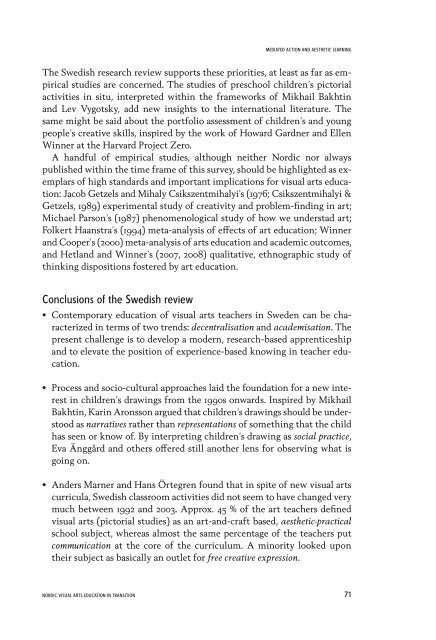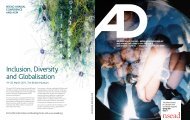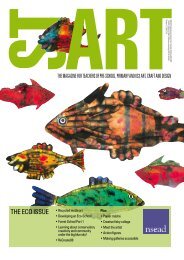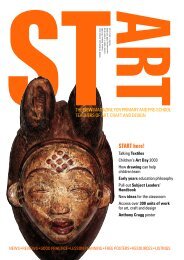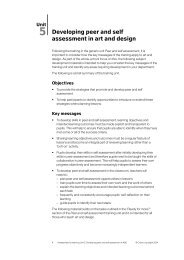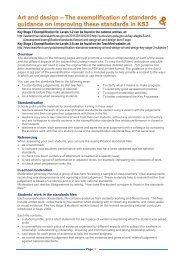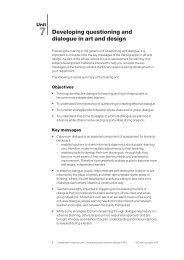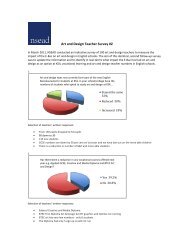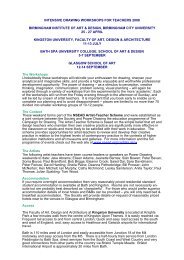Research in Visual Arts Education - Bilderlernen.at
Research in Visual Arts Education - Bilderlernen.at
Research in Visual Arts Education - Bilderlernen.at
You also want an ePaper? Increase the reach of your titles
YUMPU automatically turns print PDFs into web optimized ePapers that Google loves.
MEDIATED ACTION AND AESTHETIC LEARNINGThe Swedish research review supports these priorities, <strong>at</strong> least as far as empiricalstudies are concerned. The studies of preschool children’s pictorialactivities <strong>in</strong> situ, <strong>in</strong>terpreted with<strong>in</strong> the frameworks of Mikhail Bakht<strong>in</strong>and Lev Vygotsky, add new <strong>in</strong>sights to the <strong>in</strong>tern<strong>at</strong>ional liter<strong>at</strong>ure. Thesame might be said about the portfolio assessment of children’s and youngpeople’s cre<strong>at</strong>ive skills, <strong>in</strong>spired by the work of Howard Gardner and EllenW<strong>in</strong>ner <strong>at</strong> the Harvard Project Zero.A handful of empirical studies, although neither Nordic nor alwayspublished with<strong>in</strong> the time frame of this survey, should be highlighted as exemplarsof high standards and important implic<strong>at</strong>ions for visual arts educ<strong>at</strong>ion:Jacob Getzels and Mihaly Csikszentmihalyi’s (1976; Csikszentmihalyi &Getzels, 1989) experimental study of cre<strong>at</strong>ivity and problem-f<strong>in</strong>d<strong>in</strong>g <strong>in</strong> art;Michael Parson’s (1987) phenomenological study of how we understad art;Folkert Haanstra’s (1994) meta-analysis of effects of art educ<strong>at</strong>ion; W<strong>in</strong>nerand Cooper’s (2000) meta-analysis of arts educ<strong>at</strong>ion and academic outcomes,and Hetland and W<strong>in</strong>ner’s (2007, 2008) qualit<strong>at</strong>ive, ethnographic study ofth<strong>in</strong>k<strong>in</strong>g dispositions fostered by art educ<strong>at</strong>ion.Conclusions of the Swedish review• Contemporary educ<strong>at</strong>ion of visual arts teachers <strong>in</strong> Sweden can be characterized<strong>in</strong> terms of two trends: decentralis<strong>at</strong>ion and academis<strong>at</strong>ion. Thepresent challenge is to develop a modern, research-based apprenticeshipand to elev<strong>at</strong>e the position of experience-based know<strong>in</strong>g <strong>in</strong> teacher educ<strong>at</strong>ion.• Process and socio-cultural approaches laid the found<strong>at</strong>ion for a new <strong>in</strong>terest<strong>in</strong> children’s draw<strong>in</strong>gs from the 1990s onwards. Inspired by MikhailBakht<strong>in</strong>, Kar<strong>in</strong> Aronsson argued th<strong>at</strong> children’s draw<strong>in</strong>gs should be understoodas narr<strong>at</strong>ives r<strong>at</strong>her than represent<strong>at</strong>ions of someth<strong>in</strong>g th<strong>at</strong> the childhas seen or know of. By <strong>in</strong>terpret<strong>in</strong>g children’s draw<strong>in</strong>g as social practice,Eva Änggård and others offered still another lens for observ<strong>in</strong>g wh<strong>at</strong> isgo<strong>in</strong>g on.• Anders Marner and Hans Örtegren found th<strong>at</strong> <strong>in</strong> spite of new visual artscurricula, Swedish classroom activities did not seem to have changed verymuch between 1992 and 2003. Approx. 45 % of the art teachers def<strong>in</strong>edvisual arts (pictorial studies) as an art-and-craft based, aesthetic-practicalschool subject, whereas almost the same percentage of the teachers putcommunic<strong>at</strong>ion <strong>at</strong> the core of the curriculum. A m<strong>in</strong>ority looked upontheir subject as basically an outlet for free cre<strong>at</strong>ive expression.NORDIC VISUAL ARTS EDUCATION IN TRANSITION 71


